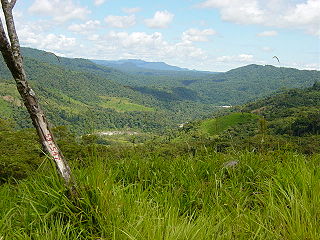
Sangay National Park is a national park located in the Morona-Santiago, Chimborazo, Tungurahua, Cañar, and Azuay provinces of Ecuador. The park contains two active volcanoes, one extinct volcano El Altar. Protecting a range of elevations from 900 to 5,319 meters above sea level, Sangay National Park contains a wide variety of habitats, including glaciers, volcanic landscapes, tropical rainforests, cloud forests, wetlands, grasslands, and one of the largest regions of páramo in Ecuador. 327 lakes feed into a vast wetland system covering 31.5 square kilometers (12.2 sq mi).
Pristimantis affinis is an endangered species of frog in the family Strabomantidae. It is endemic to Colombia. Its natural habitats are tropical high-altitude shrubland and grassland. It is threatened by habitat loss.
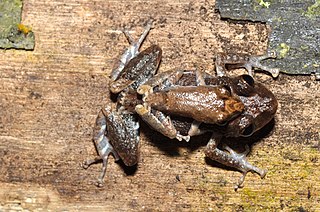
Pristimantis altamazonicus is a species of frog in the family Strabomantidae. As currently defined, it is known from the Amazon rainforest of Colombia, Ecuador, and Peru.
Pristimantis cajamarcensis is a species of frog in the family Strabomantidae. It is found in Ecuador and Peru. Its natural habitats are tropical moist montane forests, pastureland, rural gardens, and heavily degraded former forest. It is threatened by habitat loss.
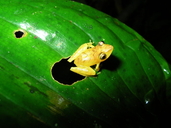
Pristimantis caryophyllaceus is a species of frog in the family Strabomantidae. It is found in Costa Rica and Panama; records from Colombia prior to 2010 refer to Pristimantis educatoris. However, taxonomy of Pristimantis caryophyllaceus and P. educatoris remain unsettled, and many sources continue to report Pristimantis caryophyllaceus from Colombia.
Pristimantis chrysops is a species of frog in the family Strabomantidae. It is endemic to Colombia. Its natural habitats are tropical moist lowland forests and moist montane forests. It is threatened by habitat loss.

Pristimantis cruentus is a species of frog in the family Strabomantidae, sometimes known as the Chiriqui robber frog. It is found in Costa Rica, Panama, and north-western Colombia. Its natural habitats are forests, including humid lowland and montane forests. It can also be found in degraded habitats outside forests. It is threatened by habitat loss.
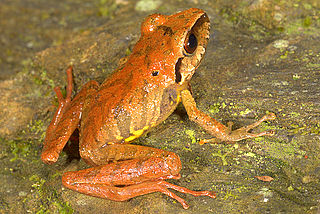
Pristimantis danae is a species of frog in the family Strabomantidae, sometimes known as Cuzco robber frog. It is found in the Andes between southern Peru and north-western Bolivia. It is named after the daughter of the author, Dana K. Duellman, who helped in collecting the frogs. Pristimantis reichlei, described in 2009, was previously confused with Pristimantis danae.

Pristimantis katoptroides is a species of frog in the family Strabomantidae. It is found in the eastern slopes of the Andes of Ecuador and Cordillera Central and eastern Andean foothills in northwestern Peru. The specific name katoptroides is Greek for "mirror-like" and refers to the similarity of this species to Pristimantis crucifer, but being found on the other side of the Andes. Common name Puyo robber frog has been proposed for it.
Pristimantis moro, also known as La Hondura robber frog, is a species of frog in the family Strabomantidae. It is found in lowland western Colombia, the Pacific versant of Panama, and the Atlantic versant of Costa Rica.

Pristimantis ornatissimus is a species of frog in the family Strabomantidae. It is endemic to Ecuador. Its natural habitats are tropical moist lowland forests and moist montane forests, at altitudes of 400–1800 meters. It is threatened by habitat loss.
Pristimantis peruvianus is a species of frog in the family Strabomantidae. It is found in the upper Amazon Basin in western Brazil, southern Ecuador, eastern Peru, and southeast Colombia. Records from Bolivia likely refer to an undescribed species, although it is possible that also the "true" Pristimantis peruvianus is to be found there. Its natural habitats are upland cloud forests, flooded lowland forests, and oxbow palm swamp forests. It is a common species.
Pristimantis walkeri is a species of frog in the family Strabomantidae. It is endemic to Ecuador. Its natural habitats are tropical dry forests, moist lowland forests, moist montane forests, plantations, rural gardens, and heavily degraded former forest. It is threatened by habitat loss.
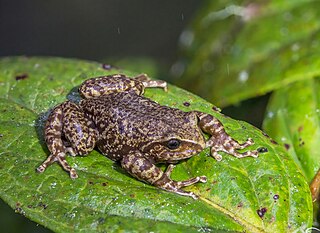
Pristimantis is a very large genus of frogs distributed in the southern Caribbean islands and in Central and South America from Honduras to northern Argentina and southern Brazil. With 596 described species, the genus had more species than any other genus of vertebrate animals. Many of these species genus are endemic to the Northwestern Andean montane forests ecoregion in north-western South America.

Pristimantis achatinus, also known as Cachabi robber frog or pastures rainfrog, is a species of frog in the family Strabomantidae. It is found from eastern Panama through Colombia to western Ecuador. Its natural habitats are both lowland and montane habitats: forest clearings, road cuts in forest, and banana, cacao and coffee plantations, as well as in forested areas. It is mostly terrestrial, sometimes occurring off the ground in vegetation. It is a very common frog.

The Northwestern Andean montane forests (NT0145) is an ecoregion on the Andes mountains in the west of Colombia and Ecuador. Both flora and fauna are highly diverse due to effect of ice ages when the warmer climate zones were separated and the cooler ones combined, and interglacial periods when the reverse occurred. Because the environment is hospitable to humans, the habitat has been drastically modified by farming and grazing since the Pre-Columbian era.

The Magdalena Valley montane forests (NT0136) is an ecoregion in the Andes mountains of central Colombia.
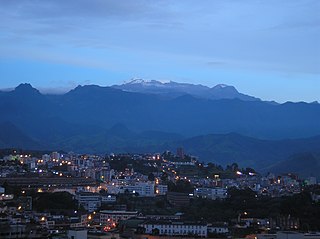
The Cauca Valley montane forests (NT0109) is an ecoregion in western Colombia. It covers the sides of the Cauca Valley, which runs from south to north between the Central and Western Ranges (cordilleras) of the Colombian Andes. The ecoregion is home to very diverse fauna and flora, due in part to its varied elevations and climates, in part to its position near the isthmus of Panama, the route along which North American species invaded South America and then diversified as they moved to the upper parts of the Andes. Little of the original habitat remains at lower levels, but higher up there are sizeable blocks of forest, some of which are protected.

The Eastern Cordillera Real montane forests (NT0121) is an ecoregion in the eastern range of the Andes of southern Colombia, Ecuador and northern Peru. The ecoregion covers the eastern slopes of the Andes, and includes montane forest that rises from the Amazonian rain forest, with cloud forest and elfin forest at higher elevations. It is rich in species, including many endemics. It is threatened by logging and conversion for pasturage and subsistence agriculture.













